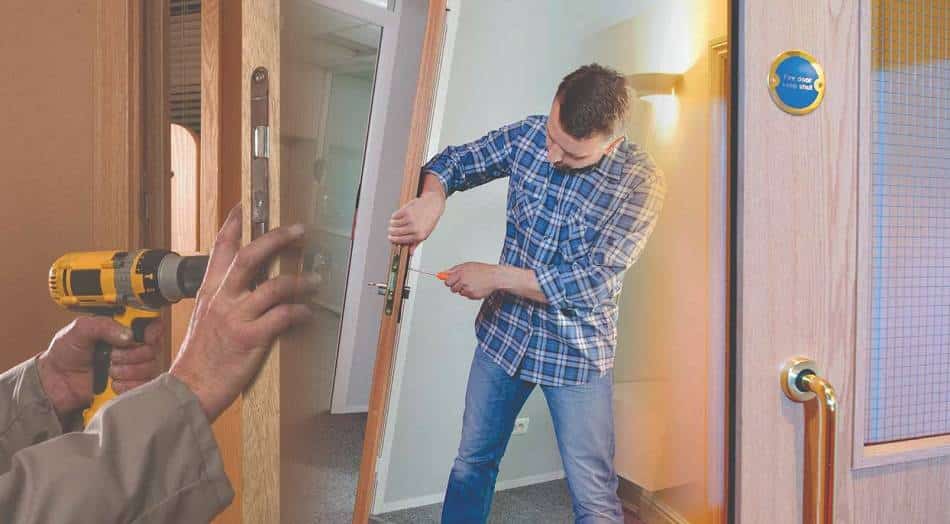Safeguarding Your Premises: The Importance of Proper Fire Door Installation

Protecting your property and the safety of its occupants is of paramount importance. Fire door maintenance plays a crucial role in ensuring the well-being of people and safeguarding assets. Regular inspections are essential to address wear and tear on fire doors, ultimately upholding their safety and effectiveness.
Understanding Fire Doors
Fire doors are designed to contain fire and smoke within the room where a fire originates. This containment prevents the rapid spread of fire, allowing individuals valuable time to evacuate safely and minimising damage to the building.
Key Features of Fire Doors:
- Fire doors are thicker than regular doors and are constructed with a non-flammable core.
- The door frame should be made from certified materials, and the gap between the frame and door should not exceed 2-3mm.
- Gaps are sealed with intumescent seals, which expand when exposed to heat from a fire.
- Fire doors come with varying fire resistance ratings, often 30 or 60 minutes, clearly labelled on the door.
Where to Use Fire Doors
Fire doors should be strategically installed to contain the spread of fire and protect fire escape routes. Common locations for fire doors include stairwells, which serve as primary escape routes. A property’s fire assessment should identify where fire doors are necessary.
Legal requirements mandate fire doors in all non-domestic properties.
Specific domestic properties, such as multiple occupancy flats, flats above a certain height, and rental properties, also require fire doors.
The Significance of Fire Door Checks
Regular fire door inspections are vital not only for safety but also for compliance with UK regulations. These inspections ensure that fire doors function correctly and can effectively contain a fire.
Key regulations include:
- The Regulatory Reform (Fire Safety) Order 2005 (RRFSO) requires the installation of fire doors when necessary.
- Conduct risk assessments.
- Implement principles of prevention.
- Establish fire safety arrangements.
- Minimise risks associated with dangerous substances.
- Firefighting and fire detection.
- Ensure emergency routes and exits.
- Define procedures for serious and imminent danger and danger areas.
Components of Fire Door Checks
Fire door inspections are thorough to guarantee safety and effectiveness. Components to be examined include:
- Certification: Ensuring all fire doors are certified, typically verified through a label or plug on the door’s top or side.
- Proper Closure: Confirm that doors with self-closing devices close fully without sticking or slamming.
- Gap Measurement: Ensuring gaps are within the specified range of 2-3mm.
- Frame Inspection: Checking door frames for damage and secure attachment to the wall.
- Seal Verification: Confirm that intumescent seals are securely attached, continuous around the door, and free from damage.
- Hinge Assessment: Verifying the presence of a minimum of three firmly fitted hinges with unbroken screws.
- Hold-Open Devices: Ensuring the proper functioning of hold-open devices, allowing doors to close in response to fire alarms.
- Latch and Handle Inspection: Checking that latches and handles open smoothly and securely hold the door in place without rattling.
- Wear and Tear Examination: Detecting any damage or wear and tear that may reduce a fire door’s effectiveness. This includes inspecting the condition of glass windows if present.
- Rating Compliance: Ensuring that each fire door carries the correct fire resistance rating for its location.
Frequency of Fire Door Checks
It is recommended to check fire doors at least every six months, as per government guidance. Regular inspections help identify wear and tear early, preventing potential issues affecting the doors’ functionality.
Responsibility for Fire Door Checks
Building owners bear the responsibility for ensuring regular fire door checks. Fire doors must be installed, inspected, and maintained by qualified professionals. When scheduling a fire door inspection, it is essential to verify the provider’s experience and qualifications. Look for accreditations such as:
- The Fire Door Inspection Scheme (FDIS): A recognised qualification which ensures the competency of fire door inspectors.
- BM TRADA: A UKAS-accredited certification body providing third-party certification for fire door manufacturing, installation, and maintenance services.
- Fire Protection Association: Offering level three training courses and awards in fire inspection.
Intertech Contracts: Your Fire Door Experts
Intertech Contracts is a leading installer of fire doors and holds accreditation under the BM TRADA Q-Mark fire door installation scheme. With over 30 years of experience, we serve clients in Hull, East Yorkshire, and throughout the UK.
Whether you’re embarking on a new build or refurbishing a property that requires fire doors, our experienced team is ready to assist you.









